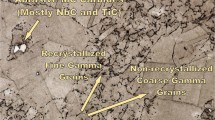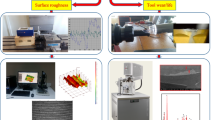Abstract
Nickel-based alloys, particularly Alloy 625, are very important materials which have been increasingly used in applications that require wear resistance, particularly in the oil and gas industries. One of their characteristics is low machinability, which is due to their combined properties of high-temperature hardness, mechanical strength, and corrosion and wear resistance. These properties mean that low cutting speeds are needed in order to increase tool life, although this is not always achieved. The main goal of this work is to evaluate different cemented carbide grades, cutting speeds, and feed per tooth rates, aiming to determine the best condition for face milling of nickel-based 625 superalloy. The tool life performance of the cutting tools and the wear mechanisms were analyzed based on the results of milling tests using a cutter with cemented carbide inserts. The main results indicate that tool wear mechanisms in the Alloy 625 milling are similar to those that occur in other nickel-based superalloys, such as 718 and 713. However, the wear rate is lower and there is evidence of occurrence of oxidation wear.
Similar content being viewed by others
References
British Petroleum (2014) Deepwater oil and gas. http://www.bp.com/en/global/corporate/sustainability/the-energy-future/deepwater-oil-and-gas.html. Accessed 20 Jul 2014
International Energy Agency (2013) How will global energy markets evolve to 2035? World energy outlook 2013 factsheet
British Petroleum (2014) BP Statistical review of world energy. London, UK
Weimer P, Pettingill HW (2004) Global overview to deepwater exploration and production. In. Petroleum systems of deepwater settings, Society of Exploration Geophysicists, Chapter 2, pp 1–39
Pollock TM, Tin S (2006) Nickel-based superalloys for advanced turbine engines: chemistry, microstructure and properties. J Propuls Power 22:361–374. doi:10.2514/1.18239
Ezugwu EO, Bonney J, Yamane Y (2003) An overview of the machinability of aeroengine alloys. J Mater Process Technol 134:233–253. doi:10.1016/S0924-0136(02)01042-7
Ziemniak SE, Hanson M (2003) Corrosion behavior of NiCrMo Alloy 625 in high temperature, hydrogenated water. Corros Sci 45:1595–1618. doi:10.1016/S0010-938X(02)00230-5
Zhu D, Zhang X, Ding H (2013) Tool wear characteristics in machining of nickel-based superalloys. Int J Mach Tools Manuf 64:60–77. doi:10.1016/j.ijmachtools.2012.08.001
Simms CT, Hagel WC (1972) The superalloys. Willey, New York
Eiselstein H, Tillack D (1991) The invention and definition of Alloy 625. In: Superalloys 718, 625 and Var. Deriv. pp 1–14
Shoemaker LE (2005) Alloys 625 and 725: trends in properties and applications. 6th Int Symp Superalloys 718, 625, 706 Deriv 409–418
Special Metals (2013) Inconel® Alloy 625. Technical report
Capitanescu D (1991) Alloy 625 weld overlays for offshore and onshore projects. In: Superalloys 718, 625 Var. Deriv. pp 821–835
Fusova L, Rokicki P, Spotz Z et al (2011) Tool wear mechanisms during machining of Alloy 625. Adv Mater Res 275:204–207. doi:10.4028/www.scientific.net/AMR.275.204
Ezugwu EO, Wang ZM, Machado AR (1998) The machinability of nickel-based alloys: a review. J Mater Process Technol 86:1–16. doi:10.1016/S0924-0136(98)00314-8
Ezugwu EO, Bonney J (2004) Effect of high-pressure coolant supply when machining nickel-base, Inconel 718, alloy with coated carbide tools. J Mater Process Technol 153–154:1045–1050. doi:10.1016/j.jmatprotec.2004.04.329
Qiao Y, Ai X, Liu ZQ (2010) Selection of tool materials and cutting parameters optimization for turning nickel-based powder metallurgy superalloy. Adv Mater Res 154–155:708–711. doi:10.4028/www.scientific.net/AMR.154-155.708
Sharman A, Dewes RC, Aspinwall DK (2001) Tool life when high speed ball nose end milling Inconel 718. J Mater Process Technol 118:29–35. doi:10.1016/S0924-0136(01)00855-X
Kitagawa T, Kubo A, Maekawa K (1997) Temperature and wear of cutting tools in high-speed machining of Inconel 718 and Ti-6A1-6V-2Sn. Wear 202:142–148. doi:10.1016/S0043-1648(96)07255-9
Yan S, Zhu D, Zhuang K et al (2014) Modeling and analysis of coated tool temperature variation in dry milling of Inconel 718 turbine blade considering flank wear effect. J Mater Process Technol 214:2985–3001. doi:10.1016/j.jmatprotec.2014.07.006
Le Coz G, Dudzinski D (2014) Temperature variation in the workpiece and in the cutting tool when dry milling Inconel 718. Int J Adv Manuf Technol 74:1133–1139. doi:10.1007/s00170-014-6006-1
Komanduri R, Hou Z (2001) A review of the experimental techniques for the measurement of heat and temperatures generated in some manufacturing processes and tribology. Tribol Int 34:653–682. doi:10.1016/S0301-679X(01)00068-8
Bhatt A, Attia H, Vargas R, Thomson V (2010) Wear mechanisms of WC coated and uncoated tools in finish turning of Inconel 718. Tribol Int 43:1113–1121. doi:10.1016/j.triboint.2009.12.053
Balazinski M, Songméné V, Kops L (1995) Improvement of tool life through variable feed milling of Inconel 600. CIRP Ann Manuf Technol 44:55–58. doi:10.1016/S0007-8506(07)62274-4
Krain HR, Sharman ARC, Ridgway K (2007) Optimisation of tool life and productivity when end milling Inconel 718TM. J Mater Process Technol 189:153–161. doi:10.1016/j.jmatprotec.2007.01.017
Stähl JE (2012) Metal cutting theories and models. Seco Tools
Black SC, Chiles V, Lissaman AJ, Martill SJ (1996) Turning and milling. In. Principles of engineering manufacture, 3rd edn. Elsevier, pp 316–371
Prengel HG, Jindal PC, Wendt KH et al (2001) A new class of high performance PVD coatings for carbide cutting tools. Surf Coat Technol 139:25–34. doi:10.1016/S0257-8972(00)01080-X
Ducros C, Benevent V, Sanchette F (2003) Deposition, characterization and machining performance of multilayer PVD coatings on cemented carbide cutting tools. Surf Coat Technol 163–164:681–688. doi:10.1016/S0257-8972(02)00656-4
Thakur A, Gangopadhyay S, Maity KP (2014) Effect of cutting speed and tool coating on machined surface integrity of Ni-based super alloy. Procedia CIRP 14:541–545. doi:10.1016/j.procir.2014.03.045
Kasim MS, Che Haron CH, Ghani JA et al (2013) Wear mechanism and notch wear location prediction model in ball nose end milling of Inconel 718. Wear 302:1171–1179. doi:10.1016/j.wear.2012.12.040
Author information
Authors and Affiliations
Corresponding author
Rights and permissions
About this article
Cite this article
Rodrigues, M.A., Hassui, A., Lopes da Silva, R.H. et al. Tool life and wear mechanisms during Alloy 625 face milling. Int J Adv Manuf Technol 85, 1439–1448 (2016). https://doi.org/10.1007/s00170-015-8056-4
Received:
Accepted:
Published:
Issue Date:
DOI: https://doi.org/10.1007/s00170-015-8056-4




